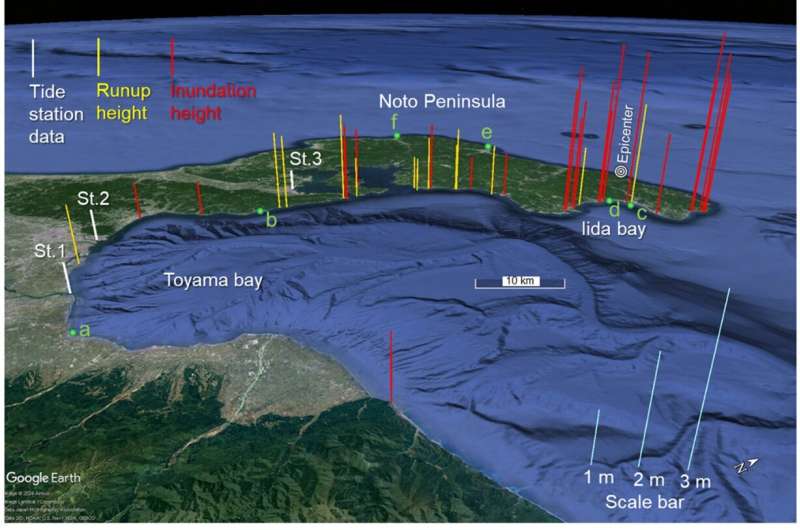This article has been reviewed according to Science X's editorial process and policies. Editors have highlighted the following attributes while ensuring the content's credibility:
fact-checked
trusted source
proofread
Researchers unveil the mechanisms for local amplification of 2024 tsunamis in Iida Bay, Japan

In 2024, a 7.5 magnitude earthquake struck the Noto Peninsula in Japan on New Year's Day, causing strong shaking, landslides, fire, liquefaction, land uplift, and devastating tsunamis. Ishikawa Prefecture, the hardest hit area, saw at least 241 fatalities, and about 75,187 houses damaged. Although the Noto Peninsula has experienced frequent earthquakes and tsunamis in the past, the 2024 tsunamis were different.
In the Ishikawa, Toyama, and Niigata prefectures, 1.3–5.8-meter-high tsunamis were confirmed. The tsunamis that hit Iida Bay, located near the epicenter of the earthquake, were significantly higher and stronger than those that hit other coasts. Tsunamis over three meters high were concentrated primarily in Iida Bay, with the area surrounding Ukai Fishing Port being most widely flooded by the tsunami.
Aerial photos and field surveys revealed that this area was flooded up to approximately 500 meters inland from the coast. Moreover, some sections of the breakwater at Iida Port collapsed, suggesting that this tsunami event was concentrated and amplified through unique mechanisms.
To unveil these mechanisms, a team of researchers from Tokyo Institute of Technology, Japan, led by Professor Hiroshi Takagi from the School of Environment and Society investigated the source of the amplification of 2024 Noto Peninsula tsunamis.
"To protect against unusual tsunamis like those that occurred in the 2024 Noto Peninsula earthquake, advanced countermeasures are required. Understanding the special mechanisms that lead to the concentration of these tsunamis is therefore of utmost importance," says Takagi. Their study was published in the journal Ocean Engineering.
The team conducted a detailed investigation into the behavior and characteristics of the tsunamis in Iida Bay using a field survey, numerical analysis, and video recordings from a monitoring camera. Their analysis revealed two main reasons for the amplification of the tsunamis.
First, the tsunami energies converged off the coast of Iida Bay due to a lens effect. In Iida Spur, an area with waters shallower than 300 meters spreading like a tongue off the coast of Iida Bay, slow-moving tsunamis hit while retaining their energy without significant dissipation.
In addition, wave refraction occurred due to the steep slope at the boundary between Iida Spur and Toyama Trough, concentrating the energy and creating the lens effect. These effects contributed to the particularly high tsunamis in Iida Bay.
Second, after reaching the bay, the first tsunami caused diffraction at the two capes and multiple reflections, triggering multiple short-period secondary tsunamis that overlapped at Iida Port and Ukai Fishing Port, causing significant damage. Video recordings overlooking Iida Port revealed that the first wave arrived around 20 minutes after the earthquake, followed by a second wave 10 minutes later.
Wavelet analysis showed that the primary tsunami wave had a period of 5–10 minutes, while the secondary waves had periods of less than two minutes. Furthermore, the video recordings showed that a bore-like tsunami propagating along the coast intersected a tsunami directly reaching Iida Port, which hit the breakwater, resulting in a 10-meter-high splash.
"Our study highlights that the damage due to tsunamis in Iida Bay was greatly influenced by local conditions, including ocean floor topology, coastline shape, the location of coastal facilities, and the fundamental seismic factors of the earthquake.
"These findings suggest that multiple tsunamis can overlap energetically within a bay, requiring more precise tsunami prediction technologies and specific countermeasures to mitigate such localized damage against similar future events," says Takagi.
More information: Hiroshi Takagi et al, Locally amplified tsunami in Iida Bay due to the 2024 Noto Peninsula Earthquake, Ocean Engineering (2024). DOI: 10.1016/j.oceaneng.2024.118180
Provided by Tokyo Institute of Technology



















